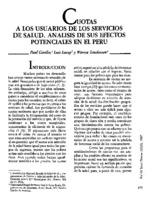Questions and Answers About the Chilean Food Act
Date
2019ISBN
978-92-5-131682-5 (FAO)
Metadata
Show full item recordOther Language Versions
Abstract
In recent decades, Chile has undergone significant changes in its population’s eating habits. According to Figure 1, in 2013 Chile was ranked second among Latin American countries in the sale of ultra-processed food and beverages per capita. The high level of consumption of these products is associated with Chile’s low level of compliance with established dietary (nutrition and food) guides. In 2010, 14% of the Chilean population followed three or more recommendations on the national food and nutrition guidelines, and only 5% stated that they followed the guidelines and have a healthy diet. Socioeconomic level and education level determine what is eaten at home, with healthier diets in the highest income quintiles and groups with higher education levels. A study based on the National Survey on Diet revealed that more income is spent on meat, bread and grains, produce, dairy products, cheese and eggs, while less income is spent on legumes, fish and oils. Even though Chile is a major producer of fish and shellfish, on average only 3% of households’ total monthly budget in the first income quintiles is spent on these products. This percentage is higher in the upper quintiles. This document was drafted by the Food and Agriculture Organization of the United Nations (FAO) and the Pan American Health Organization/World Health Organization (PAHO/WHO) in order to share insights from the Chilean experience acquired during the process of passing Law Nº 20.606 on the Nutrition Composition of Food and Advertising with members of parliament and decision makers from other countries in the Region of the Americas. This process also covers the drafting of the bill, plus its implementation and oversight, which can be applied to other similar public policy instruments aiming to benefit public health. We sincerely appreciate all the support and information we received from the various actors and sectors who were involved in this process, to wit: the Chilean Congress, academia, the private sector, civil society and the Government of Chile.
Subject
Category of PAHO Strategic Plan 2014-2019
Citation
Food and Agriculture Organization of the United Nations. Pan American Health Organization. Questions and Answers About the Chilean Food Act. Santiago: FAO, OPS; 2019.
Collections
Related items
Showing items related by title, author, creator and subject.
-
Pan American Health Organization; Noncommunicable Diseases and Mental Health (NMH) (PAHOChileSantiago, 2021)During 2019, 7.4 percent of the population in Latin America and the Caribbean (LAC) lived in hunger, which is equivalent to 47.7 million people. The situation has been deteriorating over the past 5 years, with an increase ...
-
Colomé-Hidalgo, Manuel; Donado Campos, Juan; Gil de Miguel, Ángel (2020)[ABSTRACT]. Objective. To compare inequalities in full infant vaccination coverage at two different time points between 1992 and 2016 in Latin American and Caribbean countries. Methods. Analysis is based on recent available ...
-
Gertler, Paul; Locay, Luis; Sanderson, Warren (s.d.)This article describes a discrete choice model for the demand for medical care, derived from a theoretical model that implies a natural interrelationship between price and income. The model is based on data from a 1984 ...




